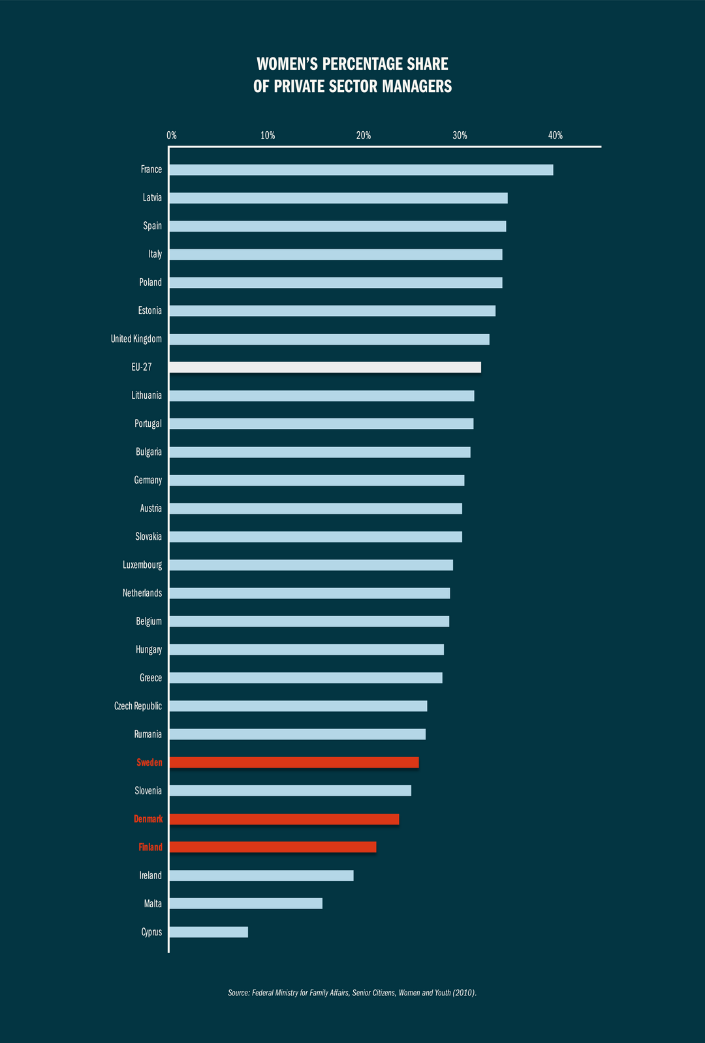If you want to find gender equality, head north. The Nordic countries top nearly all measures of women’s progress. The Mothers´ Index ranking, for example, finds that Norway is the best country in the world to be a mother in, followed by Finland, Iceland, Denmark and Sweden. The Global Gender Gap report reaches a similar conclusion, with Iceland ranked as the most gender equal country in the world followed by Norway, Finland and Sweden. As I will explain in a series of articles written exclusively for CapX, There are undeniably many reasons to admire Nordic gender equality. These societies have for a long time been, and continue to be, pioneers when it comes to creating equal opportunities.
Already during the 18th century Swedish women were given the right to run businesses and manage their property. Early Nordic capitalism was gender inclusive in a time when women in most parts of the world were treated as merely the property of their husbands. The tradition of gender equality, with roots in Viking culture, has continued in the modern era. During the 20th century, Nordic women prospered on the labor market and succeeded on their own merits – without affirmative action – to reach high political positions. Still today, the Nordic countries have unusually high employment rates amongst women and a culture where fathers take much of the responsibility for raising children. So it makes sense to admire Nordic gender equality. But there is also another face of the coin that is worth examining in greater detail.
One should expect the Nordic countries to have an abundance of women in top positions. Indeed, women have succeeded in the public sector, in politics and in being elected to corporate boards. Paradoxically however, the Nordic countries have unusually few women amongst managers in private enterprise as well as amongst business owners. As an illustrative example, the Federal Ministry for Family Affairs, Senior Citizens, Women and Youth in Germany has published a report on the topic Women in Executive Positions – Barriers and Bridges. The analyses focuses on the share of managers in the private sector, including directors and chief executives of larger organizations as well as managers of small enterprises, who are women.

As shown above, the study found that the Nordic countries have amongst the lowest share of women in management in Europe. In Sweden, only 26 per cent of private sector managers were found to be women. In Denmark (24 per cent) and Finland (22 per cent) the shares were even lower. This is far less than the European Union average of 33 per cent (or the UK rate of 34 per cent). As shown in the webpage www.nordicparadox.se a number of global surveys reach the same conclusion: the Nordic countries may be the most gender equal in theory, but in practice, they have few women reaching the top.
In fact, once we take a closer look at Nordic gender equality, a number of questions pop up.
• Why do few women reach the top of the private sector in egalitarian Nordic societies?
• Why do the Baltic nations, which have less gender equal norms, have more women managers, top executives and business owners than their Nordic neighbors? Why does the same hold true for Anglo-Saxon societies?
• Why has the celebrated affirmative action laws in Norway not helped break the glass ceiling?
As I show in the newly published book The Nordic Gender Equality Paradox, there are perfectly logical answers to these questions. Reasons exist for why Nordic nations have few women on top of the business world, although their culture and history give them a clear advantage in women’s progress. It actually makes sense that the Baltic countries, which have progressed less in terms of egalitarian attitudes, have more women managers and business owners. Lastly, we should be anything but surprised that the Norwegian government mandates are not achieving broader change in gender equality, since they are based on a wrong analysis of what is holding back women in the labour market. The conclusion is simply that policy matters.
Ample studies show that the large welfare states in the Nordics, although designed to aid in women’s progress, in fact are hindering the very same progress. Social democratic systems do provide a range of benefits for women, such as generous parental leave systems and publicly financed day care for children. The models however also have features that are detrimental to woman’s careers. Public sector monopolies in women-dominated areas such as health and education substantially reduce the opportunities for business ownership and career success amongst women. Welfare state safety nets discourage women from self-employment. Overly generous parental leave systems encourage women to stay home rather than work. Substantial tax wedges make it difficult to purchase services that substitute for household work, which reduces the ability of two parents to engage fully in the labour market.
In addition, there is a limit to how much can be achieved by state intervention. Government dictates on the percentage of women who should be given corporate board positions are apparently not a measure that promotes women’s career opportunities across the board. The glass ceiling exists in egalitarian Nordic societies not because discriminatory attitudes are prevalent (they are not) but rather because welfare state monopolies, and a larger share of women working part-time, hinders women from building up relevant experience on the labor market and through entrepreneurship. Regulating the gender distribution on corporate boards does not affect these discrepancies, and is therefore a symbolic measure affecting mainly a handful of elite women who already have reached the top.
The Nordic societies, which can trace their gender egalitarian norms to the time of their Viking ancestors, can teach us much about how gender equality can be achieved. The same countries also convey another important message, about how overly sized welfare states can hamper women’s opportunities to the top. As the ancient Persian saying goes, one should learn from both the successes and failures of others. In both regards the rest of the world should look closely at the Nordic model to learn more about woman’s career opportunities.
The Nordic Gender Equality Paradox can be ordered here.


